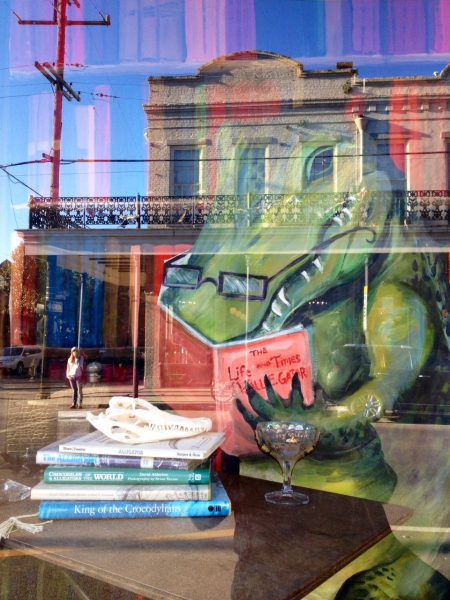Your story is one of the best stories I’ve read about a family splitting up from a child’s perspective. One of the things that struck me as I read and re-read this story is the balance between personal voice (first person narrative) and the emotional distance of the observations. Did you set out to write the story this way, or did that distance grow as you wrote the story?
The balance between personal voice and emotional distance was not premeditated. It developed organically. I suppose, in part, it reflects my unease with tackling the subject at hand. The story is a very slight exaggeration of my parents’ parting, which involved lawyers and a great deal of tug-of-war over the cultural artifacts my parents had accrued during their marriage. The chattels were divided over some years and, by the end of the separation, I found myself emotionally divorced from the events and the objects contested. In this way, emotional distance in the storytelling was a position of habit. I was also keen to introduce comic elements, and found stepping beyond first person narrative to be a route to humor. The old adage is spot on, I think. Hilarity increases with distance, or something.
The visuals in this story represent the enormity of the split: the piano, the McCahon painting (the I and the AM separated – such a fine detail!), the endings of the Agatha Christie (ouch!). And yet the small moments where the narrator actually appears in the scene are very few. How did you come to place the narrator at the edge of the story like that?
The narrator (the child) is very much an appendage of the adults in the story. The adults make things happen, while the child bears witness, wrapping a narrative around the happenings. I wanted a dispassionate transition, from the halving of an eggplant (a fairly prosaic image) to the splitting of the Siamese, the piano, and the concluding realization that the children, too, are divided. I found that the child as narrator could offer a naive and literalist conceptualization of events, and might leave the reader wondering whether the splitting is a reality or a construct of the child’s imagination. The child never speaks, is un-gendered and without name. Teetering on the edge of the story, the child reacts to the adults’ antics with hushed prudence—”This is half-witted, I would have said.”
Tell us about your writing in general and your experience with flash. Do you write longer works as well? How does flash fit into your own writing cycle and habits—and why does it appeal?
I am a habitually lazy human being. I consider this an occasional strength. I value immediacy. I drink my gin neat. I eat microwave meals. And I read the back of shampoo bottles for kicks. I love flash—it appeals to my impatience. Three hundred words of dynamite, or thereabouts. I can administer it peripatetically. I can read it between hands at poker, or stooped at a bus stop. Pithiness in writing excites me. I first came to write flash after reading a piece by Frankie McMillan. It was a mouthful of genius. I have also been stirred on by some gems in the Flash Frontier online journal. I do write longer stories too, but tend to tie myself in knots, with tangents and sub-tangents tangling or fraying at the ends. I write poetry. Poetry suits me well because I can write anything and get away with it. And I moonlight as a gangster and write really cringe-worthy rap songs. My over-arching love, though, is the words themselves. I collect them in a “word farm,” with favorites like sesquipedalian and turophile, cunctation and defenestration. I seldom introduce them to my writing, but get a buzz out of tossing them about on my tongue. Such fun!
You were recently a finalist for the 2015 Kathleen Grattan Award—one of the most prestigious poetry prizes in New Zealand. Tell us a little about your poetry collection—and also something about the line you traverse between poetry and flash.
My collection is tentatively titled Caught and comprises mostly free-verse poetry of diverse subject matter, often caught at the junction between the urban world and the natural. It is a move away from the angsty work of my adolescence and early twenties, which ought have been stashed in some bolted cupboard as a time capsule to be laughed at downstream (but was, instead, given out with Christmas cards, along with photos of starving Ethiopians). Which is not to say the current verse is upbeat! But my mother can now stand some of it.
The line between flash and poetry is, for me, a fuzzy one. For me, the difference is mostly a matter of form and hemispheric occupation. If a thicket of words chain together and, now and then, bump against the right-hand margin, I’m inclined to call it prose (either prose poetry or flash). Where my words clamber down the page, rooted to the left margin, I call that poetry. That’s a crude and pedestrian manner of distinction, but for me, it does the trick. Very often a poem ditches its leash and becomes flash, and vice versa. Or I set out to write a novel, but the world gets devoured by a super-massive black-hole around 300 words in. Then I call that flash.



 The SmokeLong Grand Micro Contest (The Mikey) is now an annual competition celebrating and compensating the best micro fiction and nonfiction online.
The SmokeLong Grand Micro Contest (The Mikey) is now an annual competition celebrating and compensating the best micro fiction and nonfiction online.